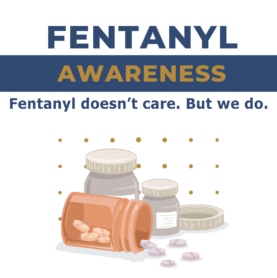Fentanyl, a synthetic opioid, is responsible for more deaths of Americans under 50 than any other cause of death, according to U.S. data. To help prevent fatal drug overdoses, San Bernardino County health officials have launched an awareness campaign called “Fentanyl Doesn’t Care. But We Do.”
In 2021, there were 354 fentanyl overdose deaths in the county. The San Bernardino County Department of Public Health issued a health advisory in October to bring attention to the dangers of fentanyl due to a significant increase in overdose deaths countywide.
Fentanyl is up to 50 times stronger than heroin and 100 times stronger than morphine. It is tasteless, odorless, and too small to see; an amount about the size of two grains of sand can cause an overdose. Not only can it be lethal to those who intentionally use the drug, but it can kill children and adults who are inadvertently exposed to it.
“There is a misperception that fentanyl only affects drug addicts when in reality, it’s affecting a broad segment of our community,” said Board of Supervisors Chair Dawn Rowe. “This campaign will help shed light on the reality of the fentanyl crisis and help us save lives.”
DBH has partnered with Stop the Void and the INTO LIGHT Project to develop a media campaign that targets geographic areas in the county with a high rate of fentanyl overdoses, with special consideration for young adults and at-risk underserved communities. This campaign aims to educate the public on the serious dangers of fentanyl, bring awareness to the prevalence in our community and most importantly, equip people with the lifesaving resources available.
“It is important to have these meaningful and timely conversations about the dangers of fentanyl, with your children, friends and loved ones – before it is too late,” said DBH Director Dr. Georgina Yoshioka. In partnership with Stop the Void and INTO LIGHT, this campaign uses real stories of individuals who lost their life due to a drug overdose.
Signs of an Overdose
Recognizing the signs of opioid overdose can save a life. Here are some things to look for:
• Small, constricted “pinpoint pupils”
• Falling asleep or losing consciousness
• Slow, weak, or no breathing
• Choking or gurgling sounds
• Limp body
• Cold and/or clammy skin
• Discolored skin (especially in lips and nails)
If you suspect a family member or friend might have a problem with substance use, speak to them about getting help. Counselors will work with you and your family member/friend to design a treatment plan. Call (800) 968-2636 to reach the Substance Use Disorder Helpline, 24-hours of the day for a free and confidential screening.
Click here for more information about the campaign.


